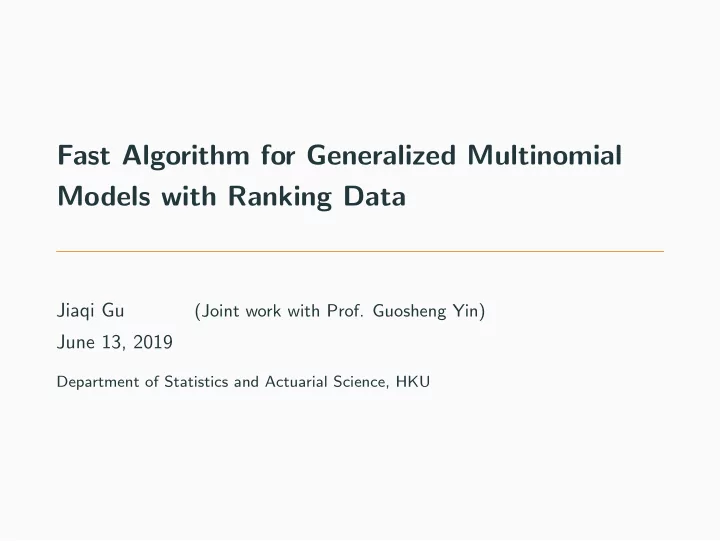

Fast Algorithm for Generalized Multinomial Models with Ranking Data Jiaqi Gu (Joint work with Prof. Guosheng Yin) June 13, 2019 Department of Statistics and Actuarial Science, HKU
Generalized multinomial models Consider d basic cells c 1 , . . . , c d , where c i is assigned with cell probability p i ( � d i =1 p i = 1). Suppose cell c i is chosen for a i times ( i = 1 , . . . , d ), then the log-likelihood function is d � ℓ ( p ) = a i log p i . (1) i =1 Completeness condition: Sets of basic cells for selection are always { c 1 } , . . . , { c d } . (choose 1 from d ) If completeness condition is violated: • Union of sets for selection includes only a fraction of basic cells. (choose 1 from k < d ) • Sets for selection consists of more than one basic cell. (choose l > 1 from d ) → Incomplete multinomial models. 1
Log-likelihood function n � � � � � ℓ ( p ) = log( p i ) − log( p i ) (2) , j =1 c i ∈ A j c i ∈C j where C j is the union of sets for selection, A j is the selected set in j -th record. Examples: • Placett–Luce model [3, 4]; • Bradley–Terry model [1]; • Contingency table model [2]. 2
Markov chain based algorithm Denote W i = { j : c i ∈ A j } and L i = { j : c i ∈ ( C j \ A j ) } , q + c i ∈ A j p i and q ∗ j = � j = � c i ∈C j p i , n � � � log( q + j ) − log( q ∗ ℓ ( p ) = j ) . j =1 Letting ∂ℓ ( p ) = 0, we have ∂ p i � � � � p i p i ′ � � � � p i ′ = p i , q + q + j q ∗ j q ∗ (3) j j i ′ � = i j ∈ W i ∩ L i ′ i ′ � = i j ∈ L i ∩ W i ′ ( i = 1 , . . . , d ) . 3
Markov chain based algorithm 4
Experiments: Convergence Estimator obtained by our algorithm is close to the MLE, indicating our algorithm’s convergence to the MLE. 5
Experiments: Convergence rate Figure 1: Path of iterations for three algorithms on sushi data 6
Experiments: Computational efficiency • Choose 1 from k < d : • Choose l > 1 from d : 7
Discussions • Our algorithm obtain the MLE efficiently than existing methods. • Further improvement. (Especially in situation ”choose l > 1 from d ”) 8
Reference Ralph Allan Bradley and Milton E. Terry. Rank Analysis of Incomplete Block Designs: I. The Method of Paired Comparisons. Biometrika , 39(3/4):324–345, 1952. Tar Chen and Stephen E. Fienberg. The Analysis of Contingency Tables with Incompletely Classified Data. Biometrics , 32(1):133, 1976. R. Duncan Luce. Individual Choice Behavior: A Theoretical analysis. Wiley, 1959. R. L. Plackett. The Analysis of Permutations. 9 Applied Statistics , 24(2):193–202, 1975.
End Thank you for listening. 10
Recommend
More recommend